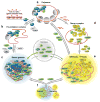Relationship of GW/P-bodies with stress granules
- PMID: 23224972
- PMCID: PMC4317337
- DOI: 10.1007/978-1-4614-5107-5_12
Relationship of GW/P-bodies with stress granules
Abstract
Whereas P-bodies are intimately linked to the cytoplasmic RNA decay machinery, stress granules harbor stalled translation initiation complexes that accumulate upon stress-induced translation arrest. In this Chapter, we reflect on the relationship between P-bodies and stress granules. In mammalian cells, the two structures can be clearly distinguished from each other using specific protein or RNA markers, but they also share many proteins and mRNAs. While the formation of P-bodies and stress granules is coordinately triggered by stress, their assembly appears to be regulated independently by different pathways. Under certain types of stress, P-bodies frequently dock with stress granules, and overexpressing certain proteins that localize to both structures can cause P-body/stress granule fusion. Currently available data suggest that these self-assembling compartments are controlled by flux of mRNAs within the cytoplasm, and that their assembly mirrors the translation and degradation rates of their component mRNAs.
Figures


Similar articles
-
Relationship of other cytoplasmic ribonucleoprotein bodies (cRNPB) to GW/P bodies.Adv Exp Med Biol. 2013;768:213-42. doi: 10.1007/978-1-4614-5107-5_13. Adv Exp Med Biol. 2013. PMID: 23224973 Review.
-
Deadenylation and P-bodies.Adv Exp Med Biol. 2013;768:183-95. doi: 10.1007/978-1-4614-5107-5_11. Adv Exp Med Biol. 2013. PMID: 23224971 Free PMC article. Review.
-
P bodies promote stress granule assembly in Saccharomyces cerevisiae.J Cell Biol. 2008 Nov 3;183(3):441-55. doi: 10.1083/jcb.200807043. J Cell Biol. 2008. PMID: 18981231 Free PMC article.
-
Analyzing P-bodies and stress granules in Saccharomyces cerevisiae.Methods Enzymol. 2010;470:619-40. doi: 10.1016/S0076-6879(10)70025-2. Epub 2010 Mar 1. Methods Enzymol. 2010. PMID: 20946828
-
Eukaryotic stress granules: the ins and outs of translation.Mol Cell. 2009 Dec 25;36(6):932-41. doi: 10.1016/j.molcel.2009.11.020. Mol Cell. 2009. PMID: 20064460 Free PMC article. Review.
Cited by
-
Differential effects of Ydj1 and Sis1 on Hsp70-mediated clearance of stress granules in Saccharomyces cerevisiae.RNA. 2015 Sep;21(9):1660-71. doi: 10.1261/rna.053116.115. Epub 2015 Jul 21. RNA. 2015. PMID: 26199455 Free PMC article.
-
The role of cold shock domain proteins in inflammatory diseases.J Mol Med (Berl). 2014 Mar;92(3):207-16. doi: 10.1007/s00109-014-1136-3. Epub 2014 Feb 22. J Mol Med (Berl). 2014. PMID: 24562821 Review.
-
An evolutionarily conserved RNase-based mechanism for repression of transcriptional positive autoregulation.Mol Microbiol. 2014 Apr;92(2):369-82. doi: 10.1111/mmi.12564. Epub 2014 Mar 19. Mol Microbiol. 2014. PMID: 24612392 Free PMC article.
-
UVC-induced stress granules in mammalian cells.PLoS One. 2014 Nov 19;9(11):e112742. doi: 10.1371/journal.pone.0112742. eCollection 2014. PLoS One. 2014. PMID: 25409157 Free PMC article.
-
KSHV RNA-binding protein ORF57 inhibits P-body formation to promote viral multiplication by interaction with Ago2 and GW182.Nucleic Acids Res. 2019 Sep 26;47(17):9368-9385. doi: 10.1093/nar/gkz683. Nucleic Acids Res. 2019. PMID: 31400113 Free PMC article.
References
-
- Arimoto K, Fukuda H, Imajoh-Ohmi S, Saito H, Takekawa M. Formation of stress granules inhibits apoptosis by suppressing stress-responsive MAPK pathways. Nat Cell Biol. 2008;10:1324–1332. - PubMed
-
- Athanasopoulos V, Barker A, Yu D, Tan AH, Srivastava M, Contreras N, Wang J, Lam KP, Brown SH, Goodnow CC, Dixon NE, Leedman PJ, Saint R, Vinuesa CG. The ROQUIN family of proteins localizes to stress granules via the ROQ domain and binds target mRNAs. FEBS J. 2010;277:2109–2127. - PubMed
-
- Baez MV, Boccaccio GL. Mammalian Smaug is a translational repressor that forms cytoplasmic foci similar to stress granules. J Biol Chem. 2005;280:43131–43140. - PubMed
Publication types
MeSH terms
Substances
Grants and funding
LinkOut - more resources
Full Text Sources
Molecular Biology Databases

